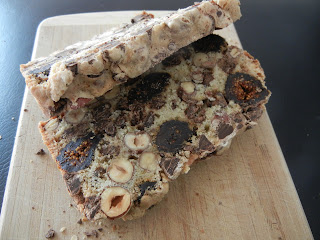I'm kind of shocked that it worked. There are a few notable differences in the creation, but otherwise this recipe is essentially an ingredient "swap out" equivalent to the classic marshmallow recipe I have posted here (and is from Alton Brown, mildly adapted all over the internet).
So, substitute in the classic recipe, cup-for-cup: Agave syrup (replaces corn syrup), and organic cane sugar (granulated to the same fineness as regular granulated sugar). And, instead of using powdered sugar for dusting, you blenderize some of that organic cane sugar with cornstarch to make your own.
Here's what I found:
1. I used "Wholesome Sweeteners Organic Blue Agave nectar" in "light" version.
2. I bought my organic cane sugar in bulk from WinCo and it had some hard chunks in it -- so I measured out what I needed with the smallest size of chunks so that it wouldn't cause problems dissolving in the candy concoction.
3. MAJOR DIFFERENCE #1: My candy foamed like CRAZY. Like, I wished I had put it in a giant pot so that I didn't have to keep taking it off the heat. It was slightly stressful and took about 10 minutes of careful handling putting it on and taking it off and stirring like crazy to keep it from boiling over while trying to get it to 240. I barely got it there, so I don't know if that factors into the next discovery.
4. MAJOR DIFFERENCE #2: Not only is the liquid candy a lot darker, it's a lot less viscous -- runny, thin, almost watery. I was worried it would not set at all when I put it in the KitchenAid with the gelatin/water combo. In fact it was so runny that it was spitting sugar everywhere. I put a towel over my KitchenAid for the first 5 minutes of whipping until it had gained enough substance to not spit hot candy drops all over.
5. MAJOR DIFFERENCE #3: It tastes almost sickeningly sweet if you taste it before it sets. Oddly, this over-sweetness seemed to diminish by the time I cut them -- and they tasted normal to me.
6. MAJOR DIFFERENCE #4: The finished product is so soft and spongy, I waited 2 days (in very dry climate) to pop them out of their tray and slice them into individual mallows. They did hold, but they are very soft.
7. NOT-SO-MAJOR DIFFERENCE #5: You can definitely taste some of the darker tones of the agave that somewhat mask the vanilla bean. Not a lot. Just a bit. And the marshmallows are more off-white in color.
There ya have it! If you want to make unrefined sugar marshmallows, it's actually quite straightforward and doable!
So, substitute in the classic recipe, cup-for-cup: Agave syrup (replaces corn syrup), and organic cane sugar (granulated to the same fineness as regular granulated sugar). And, instead of using powdered sugar for dusting, you blenderize some of that organic cane sugar with cornstarch to make your own.
Here's what I found:
1. I used "Wholesome Sweeteners Organic Blue Agave nectar" in "light" version.
2. I bought my organic cane sugar in bulk from WinCo and it had some hard chunks in it -- so I measured out what I needed with the smallest size of chunks so that it wouldn't cause problems dissolving in the candy concoction.
3. MAJOR DIFFERENCE #1: My candy foamed like CRAZY. Like, I wished I had put it in a giant pot so that I didn't have to keep taking it off the heat. It was slightly stressful and took about 10 minutes of careful handling putting it on and taking it off and stirring like crazy to keep it from boiling over while trying to get it to 240. I barely got it there, so I don't know if that factors into the next discovery.
4. MAJOR DIFFERENCE #2: Not only is the liquid candy a lot darker, it's a lot less viscous -- runny, thin, almost watery. I was worried it would not set at all when I put it in the KitchenAid with the gelatin/water combo. In fact it was so runny that it was spitting sugar everywhere. I put a towel over my KitchenAid for the first 5 minutes of whipping until it had gained enough substance to not spit hot candy drops all over.
5. MAJOR DIFFERENCE #3: It tastes almost sickeningly sweet if you taste it before it sets. Oddly, this over-sweetness seemed to diminish by the time I cut them -- and they tasted normal to me.
6. MAJOR DIFFERENCE #4: The finished product is so soft and spongy, I waited 2 days (in very dry climate) to pop them out of their tray and slice them into individual mallows. They did hold, but they are very soft.
7. NOT-SO-MAJOR DIFFERENCE #5: You can definitely taste some of the darker tones of the agave that somewhat mask the vanilla bean. Not a lot. Just a bit. And the marshmallows are more off-white in color.
There ya have it! If you want to make unrefined sugar marshmallows, it's actually quite straightforward and doable!










.jpg)
.jpg)
.jpg)
.jpg)
.jpg)
.jpg)







